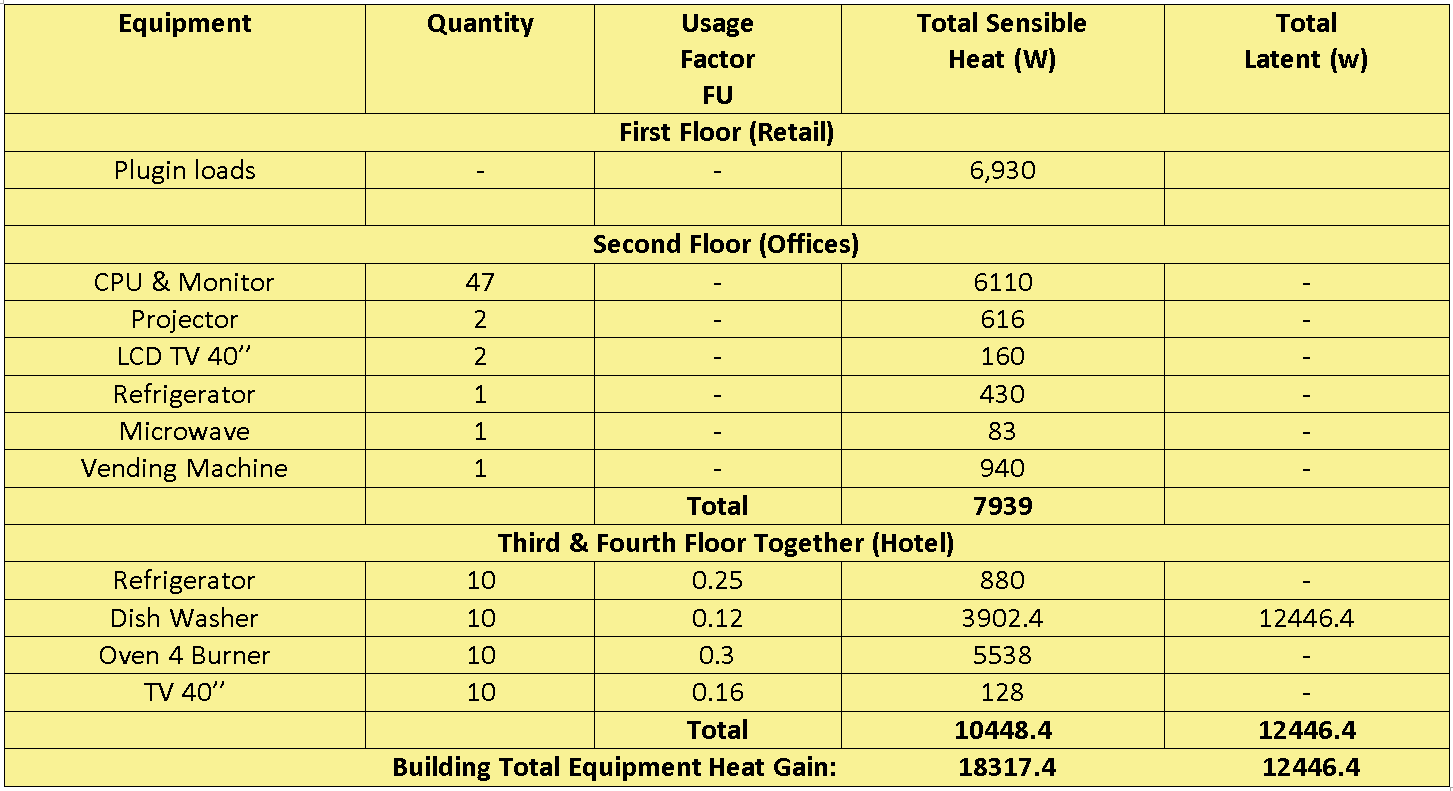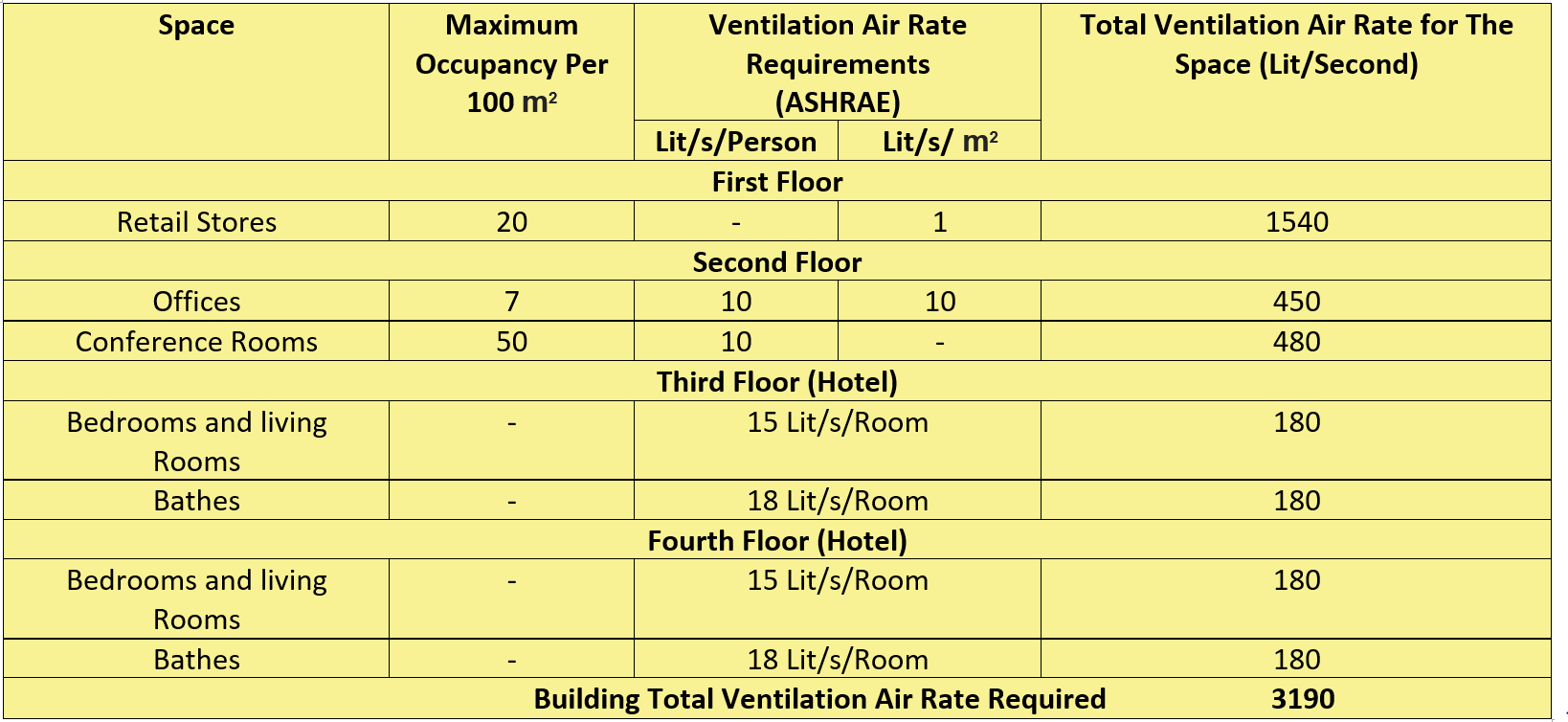
Detailed building energy simulations have been carried out using a dynamic simulation program ESP-r. A base case building model of the representative building was developed. It was decided to adopt the building design from the ASHRAE 2018 design competition, to design an energy efficient project approaching ''Zero Energy'' building with minimized energy demand and incorporate locally available or building-installed renewable energy sources (RES).
The building that was studied is a 70,000 square foot (6,500 square meter), four story mixed use complex. It includes offices, retail stores, conference rooms, and hotels. The offices and administrative support spaces are open 11 hours per day (7-18) Monday to Friday and 5 hours per day (8-13) on satarday, retail open 13 hours per day (9-22) Monday to Saturday and 8 hours per day (11-19) on Sunday, hotels open 24/7.
| Space Type | Area (m^2) | Occupancy per 100 M^2 | Total Occupancy |
|---|---|---|---|
| First Floor | |||
| Retail | 1255 | 15 | 188 |
| Lobby | 45 | 50 | 22 |
| Service Rooms | - | - | 8 |
| Total: 218 | |||
| Second Floor | |||
| Offices | 903 | 5 | 45 |
| Conference Rooms | 95 | 50 | 48 |
| Lobbies | 53 | 10 | 5 |
| Break Rooms | 32 | 50 | 16 |
| Storage | 32 | 2 | 1 |
| Total: 115 | |||
| Third Floor | |||
| Hotel | - | - | 60 |
| Forth Floor | |||
| Hotel | - | - | 60 |
| Total Building Occupncy: 453 Persons |
| Space Type | Occupants | Activity | Sensible Heat Gain (W/person) | Latent Heat Gain (W/person) | Total Sensible Heat(W) | Total Latent Heat(W) |
|---|---|---|---|---|---|---|
| Retail | 188 | Standing, Light Work, Walking | 75 | 55 | 14,100 | 10,340 |
| Lobby | 22 | Walking, Light Work | 75 | 55 | 1650 | 1210 |
| Service Rooms | 8 | Light Work | 75 | 55 | 600 | 440 |
| Total First Floor | 16,350 | 11,990 | ||||
| Offices | 45 | Seated, Very Light Work | 70 | 45 | 3150 | 2025 |
| Break Room, Resturant | 16 | Sedentary Work | 80 | 80 | 1280 | 1280 |
| Lobby | 5 | Walking, Light Work | 75 | 55 | 375 | 275 |
| Conference Rooms | 48 | Seated, Very Light Work | 70 | 45 | 3360 | 2160 |
| Storage | 1 | Meduim Work | 75 | 75 | 75 | 75 |
| Total Second Floor | 8,240 | 5,815 | ||||
| Hotel Third Floor | 60 | Seated, Very Light Work | 70 | 45 | 4200 | 2700 |
| Hotel Forth Floor | 60 | Seated, Very Light Work | 70 | 45 | 4200 | 2700 |
| Total Occupants Sensible Heat Gain: | 32,990 W | Total Occupants Latent Heat Gain: | 23,205 W |
| Space Type | LPD (W/m^2) |
|---|---|
| Sales Area | 15.5 |
| Enclosed Office | 12 |
| Office Open Plan | 10.6 |
| Lounges/Break Rooms | 7.9 |
| Storage Rooms | 13.3 |
| Corridor | 7.1 |
| Conference Room | 13.3 |
| Lobbies | 9.7 |
| Hotel Guest Rooms | 12 |
| Hotel Lobby | 11.4 |
Equipment
Equipment such as computers in offices result in heat gains to the room equal to the total power input. The internal heat gains can be estimated from basic data but care must be taken to allow for diversity of use, idle operation and the effects of energy saving features of the equipment.

Diversity Factor
Diversity factor accounts for the occupants behavior as not all equipment and computers will be turned on at the same time and not all the hotel rooms will be occupied at the same time.
So a diversity factor for the offices was taken to be 0.6 for the office equipment and the occupants casual gains.[3]
A similar factor was used for the hotel to account for the occupants behaviour in the equipment use, lighting use and occupants casual gains.
The same factor was used in the retail floor to account for the plug-in loads and occupants casual gains.

[1] CIBSE Guide A Chapter 6 ‘Internal heat gains’
[2] ASHRAE Fundamentals 2017
[3] Elharidi, A., Tuohy, P. and Teamah, M. (2018). The energy and indoor environmental performance of Egyptian offices: Parameter analysis and future policy. Energy and Buildings, 158, pp.431-452.